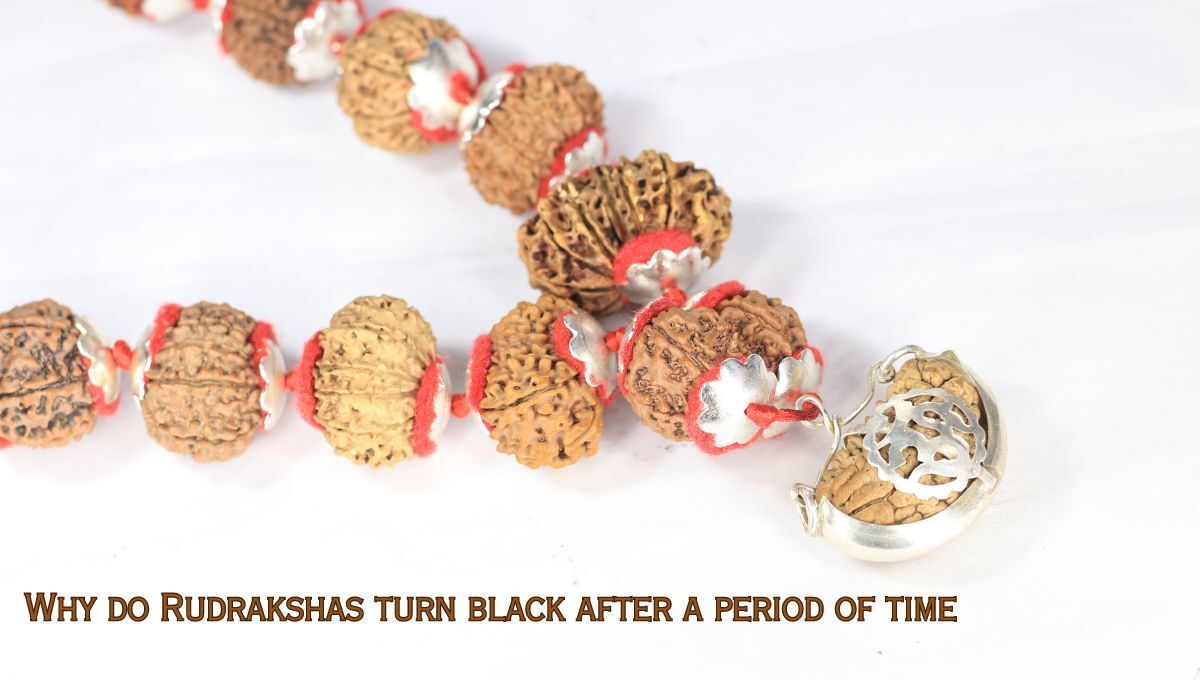Rudraksha beads, revered in Hinduism and other spiritual practices, are not only known for their aesthetic beauty but also for their mystical significance. These sacred seeds, believed to embody the tears of Lord Shiva, hold a profound place in the hearts of millions. However, one phenomenon that often perplexes enthusiasts is the gradual darkening of these beads over time. What causes this transformation, and what does it signify? Join us as we delve into the intriguing world of Rudrakshas and unravel the mysteries behind their enigmatic color change. This comprehensive blog post will completely cater to your till yet no quenched query – why do rudrakshas turned black.
Table of Contents
The Origin of Rudraksha:
To understand the phenomenon of one Mukhi Rudraksha turning black, it’s imperative to delve into their origin and significance. According to Hindu mythology, Rudraksha seeds are believed to have originated from the tears of Lord Shiva, the supreme deity of destruction and regeneration. Legend has it that upon witnessing the suffering of humanity, Shiva was moved to tears, and as his tears fell upon the earth, they crystallized into the sacred Rudraksha beads. Thus, these beads are not merely botanical entities but spiritual artifacts imbued with divine energy.
Read Worthy: –Can I Wear Gemstones & Rudraksha Together?
The Sacred Symbolism:
Rudraksha beads are revered for their potent spiritual energy and are often used in meditation, prayer, and healing practices. Each bead is characterized by a varying number of facets or “mukhis,” with each type believed to possess unique properties and benefits. These 4 Mukhi Rudraksha beads are worn as necklaces, bracelets, or malas (prayer beads), with devotees attributing them with the power to enhance concentration, promote tranquility, and protect against negative energies.
The Enigmatic Color Change:
One of the intriguing aspects of 11 Mukhi Rudraksha beads is their tendency to undergo a gradual color change, often darkening over time. While initially, these beads may exhibit a lustrous brown or reddish hue, they can eventually turn black or dark brown. This transformation, while seemingly mundane, carries profound symbolism in spiritual circles.
The Scientific Explanation Behind Darkness Occuring on Rudraksha
From a scientific standpoint, the darkening of 13 Mukhi Rudraksha beads can be attributed to various factors, including exposure to body oils, sweat, moisture, and environmental conditions. Over time, the oils and moisture from the wearer’s skin can penetrate the porous surface of the beads, leading to oxidation and a darkening of the outer layer. Additionally, prolonged exposure to sunlight and air can also contribute to this process.
Peek Here: – Benefits of Gauri Shankar Rudraksha
The Spiritual Interpretation
While the scientific explanation sheds light on the physical mechanisms behind the color change, many spiritual practitioners believe that there is a deeper significance to this phenomenon. According to spiritual lore, the darkening of 15 Mukhi Rudraksha beads symbolizes the absorption of negative energies and impurities from the wearer’s surroundings. In essence, it is believed that the beads act as spiritual sponges, cleansing the wearer’s aura and purifying their soul.
Furthermore, some interpret the darkening of Rudraksha beads as a sign of their maturity and enhanced spiritual potency. Just as a ripened fruit develops a richer flavor and aroma, the deepening color of Rudraksha beads is seen as an indication of their heightened vibrational energy and efficacy in spiritual practices.
Other Significant Reasons for Blackness on Rudraksha Beads
Oxidation – Exposure to air and moisture can cause the rudraksha beads to oxidize over time, making them appear darker or blackened. This is a natural process.
Contact with oils and chemicals – Rudraksha beads are porous and can absorb oils from the skin as well as chemicals from perfumes, soaps, etc. These can discolor the beads.
Improper care – Keeping 7 Mukhi rudraksha beads in very humid environments or failing to clean them properly can cause buildup of dirt, grime and oils that darken the beads.
Must Read: – Why There are 108 Beads on a Rudraksha Mala
Fake beads – Some fake plastic and glass beads that mimic rudraksha are painted black or dyed to look like real rudraksha beads. Genuine rudraksha has a natural lighter brown color.
Exposure to heat – High heat, such as from leaving beads exposed to sunlight or near heat sources, can alter the color and make them appear darker.
Age and use – With regular wear and use over many years, the color of rudraksha beads may slowly darken or turn blackish naturally. Older beads tend to be darker.
Chemical treatment – Some 9 Mukhi rudraksha beads are treated with chemicals to artificially blacken them and pass them off as high quality beads. This should be avoided.
Proper care like cleaning, storing away from heat/moisture, and avoiding contact with chemicals/oils can help prevent discoloration and preserve the beads’ natural color. Genuine high quality rudraksha will usually maintain its lighter brownish color for many years.
Conclusion
The enigmatic color change exhibited by Rudraksha beads serves as a reminder of their profound spiritual significance and transformative power. Whether viewed through a scientific lens or interpreted within the realm of spirituality, this phenomenon underscores the dynamic interplay between the physical and metaphysical dimensions of existence. As devotees continue to harness the energy of Rudraksha beads in their spiritual journey, they are reminded of the eternal cycle of growth, purification, and transcendence that defines the human quest for enlightenment.
Check Out: – How To Care & Worship Rudraksha Properly
